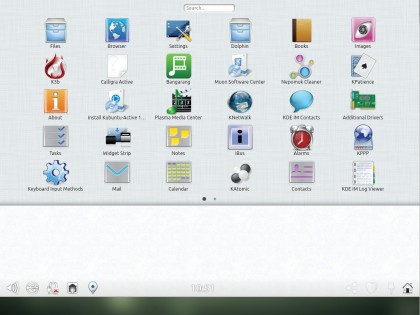Next-gen mobile OSes: what's in store?
A new frontier of Linux-based mobile operating systems
Plasma Active
KDE for mobile devices.

Most mobile devices, from iPhones to Androids are designed primarily for consuming content. They're great for watching videos, surfing the web or listening to music. However, they're not so good at creating content.
This isn't necessarily a problem because most of us aren't looking for a device to write an essay, or do some programming on as that's what our main computers are for. The mobile nirvana is a device that can bridge the two areas. That is, be simple enough to use easily with the touchscreen interface, yet complex powerful enough to do real work on.
The KDE community along with BasysKom and open-six are trying to perform just such a feat with Plasma Active. This is a version of the popular KDE desktop built specially for mobile devices. Since it's taken from KDE, all the popular KDE apps are available, including the Calligra Suite.
Even from a quick glance, the KDE heritage is apparent, though that's mainly from the theme used by the GUI and the icon set. There's no K menu to launch applications, and no Window List. Instead, the main action happens when you pull down the top bar (which is similar to how you access notifications in Android). Here you'll find both a list of open apps, and a searchable grid of installed applications.
Bizarrely for a product of the KDE community, this is quite similar to Gnome 3's Dash. The pull-down to expose more complex features works well, and we feel it offers the best window management of any of the mobile OSes we've used.
The killer feature of Plasma Active, though, is Activities. These, like their KDE counterpart, are a little like souped-up virtual desktops where you can combine widgets and apps to make separate desktop environments that you can easily flip through. To switch Activities, you simply have to pull a tab out of the right-hand side of the screen, then select the one you want from a list. It's a movement that feels natural on a touch interface.
Get daily insight, inspiration and deals in your inbox
Sign up for breaking news, reviews, opinion, top tech deals, and more.
While Activities do have their proponents on the desktop, we've found that few KDE users find them particularly useful. Many people are just confused by what they do, and we're yet to see a distribution that comes with a useful set of Activities running by default. Could the mobile arena be where they shine?
Uniquely among the mobile operating systems we've tested, Plasma Active has distributions much like desktop and server versions do. Getting the interface just right will be a task for these distributions, but it remains to be seen if any of these will put in the effort to make a good mobile product.
Like with Ubuntu Touch's Scopes, getting the right activities available by default will be crucial to Plasma Active's success. It's unlikely that many users will spend time configuring unless they can see that they'll be useful. Also like Ubuntu, this is an area that KDE haven't done well in on the desktop.
Plasma Active feels much closer to a desktop OS than any of the others we've looked at here. Perhaps it could be considered a closer competitor to Microsoft's Surface Pro than Android and iOS powered tablets? It's the one that we feel has the best chance of bridging the gap between content consumption devices and content creation devices. Being able to switch activities depending on what you are currently doing would be a real boon in this area. For example, having one activity setup for checking email and surfing the web on the go, and another for desktop-like activities with a keyboard plugged in.